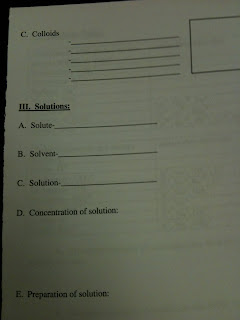To Begin class today we went over the lab test from Friday and went over many different ways to solve the problem. To Refresh on Friday we were given salt and asked to create a solution with a .15 molarity. One of the ways that was brought up was to use a sample volume and calculate the number of mols. Here's a different way to solve the problem.
.15M= Mol’s
58.44 g NaCl 1.5/58.44
.15M= .o2567mol/ x
.171L
171ML
After we went over the different ways to solve the lab quiz we were given a sheet to complete on chemthink. To get to the lab go to chemthink click labs chemical reations labs and then click Precipitate lab.
After we briefly went over the lab we took notes on the rules of solubility.
Compounds always Soluble in water | Unless they have this |
Ammonium NH4 | |
Potassium K | |
Sodium Na | |
Nitrate NO3 | |
Chlorine CL | Ag Hg Pb |
Acetate C2 H3 O2 | Fe Al Hg2 |
Sulfate | Ca Ba Pb Sr Hg2 |
Compounds always insoluble | Unless they have this |
Oxide O2 | K Na NH4 LI |
Carbonate Co3 | K Na LI NH4 |
Hydroxide OH | K Na Ba LI |
Phosphate PO4 | K Na NH4 |
Silicate SiO3 | K Na |
Sulfide S2 | K Na NH4 |
Sulfite SO3 | K Na NH4 |
The homework for the night was to Complete the lab on chemthink and to continue practicing solubility reatcions.
























